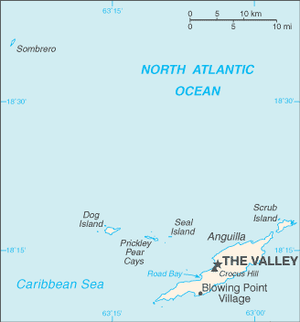Republic of Anguilla
| Republic of Anguilla | ||||||||||
| Unrecognized state | ||||||||||
| ||||||||||
| ||||||||||
 | ||||||||||
| Capital | The Valley | |||||||||
| Languages | English | |||||||||
| Government | Republic | |||||||||
| Council Chairman | ||||||||||
| • | 1967 | Peter Adams | ||||||||
| • | 1967–1969 | Ronald Webster | ||||||||
| Finance Minister | Walter Hodge | |||||||||
| Legislature | Island Council | |||||||||
| History | ||||||||||
| • | First declaration of independence | 12 July 1967 | ||||||||
| • | Second declaration of independence | 7 February 1969 | ||||||||
| • | Occupied by UK | 19 March 1969 | ||||||||
| • | Interim agreement | July 1971 | ||||||||
| Area | ||||||||||
| • | 1967 | 91 km² (35 sq mi) | ||||||||
| Population | ||||||||||
| • | 1967 est. | 5,500 | ||||||||
| Density | 60.4 /km² (156.5 /sq mi) | |||||||||
| Currency | Anguilla Liberty dollar | |||||||||
| ||||||||||
| Today part of | | |||||||||
On 27 February 1967, Britain granted the territory of Saint Christopher-Nevis-Anguilla the status of "associated state", with its own constitution and a considerable degree of self-government. Many Anguillans strenuously objected to the continuing political subservience to Saint Kitts, and on 30 May (known as Anguilla Day), the Saint Kitts police were evicted from the island. The provisional government requested United States administration, which was declined. On 11 July 1967 a referendum on Anguilla's secession from the fledgling state was held. The results were 1,813 votes for secession and 5 against. A declaration of independence (written mainly by Harvard Law professor Roger Fisher) was read publicly by Walter Hodge.[1]
A separate legislative council was immediately established. Peter Adams served as the first Chairman of the Anguilla Island Council, but when he agreed to take Anguilla back to St. Kitts, he was deposed and replaced by Ronald Webster. In December 1967, two members of Britain's Parliament worked out an interim agreement by which for one year a British official would exercise basic administrative authority along with the Anguilla Council. Tony Lee took the position on 8 January 1968, but by the end of the term no agreement had been reached on the long-term future of the island's governance.
On 6 February 1969, Anguilla held a second referendum resulting in a vote of 1,739 to 4 against returning to association with Saint Kitts. The next day Anguilla declared itself an independent republic, with Webster again serving as Chairman. A new British envoy, William Whitlock, arrived on 11 March 1969 with a proposal for a new interim British administration. He was quickly expelled. On 19 March, a contingent of 2nd Battalion, The Parachute Regiment plus forty Metropolitan Police officers, peacefully landed on the island, ostensibly to "restore order". That autumn, the troops left and Army engineers were brought in to improve the public works.
Tony Lee returned as Commissioner and in 1971 worked out another "interim agreement" with the islanders. Effectively, Anguilla was allowed to secede from Saint Kitts and Nevis, although it was not until 19 December 1980 that Anguilla formally disassociated itself from Saint Kitts and became a separate British dependency. While Saint Kitts and Nevis went on to gain full independence from Britain in 1983, Anguilla remains a British overseas territory.
References
- ↑ Westlake, Donald (1972). Under an English Heaven. New York: Simon & Schuster. pp. 78–79. ISBN 0-671-21311-3.
.svg.png)
